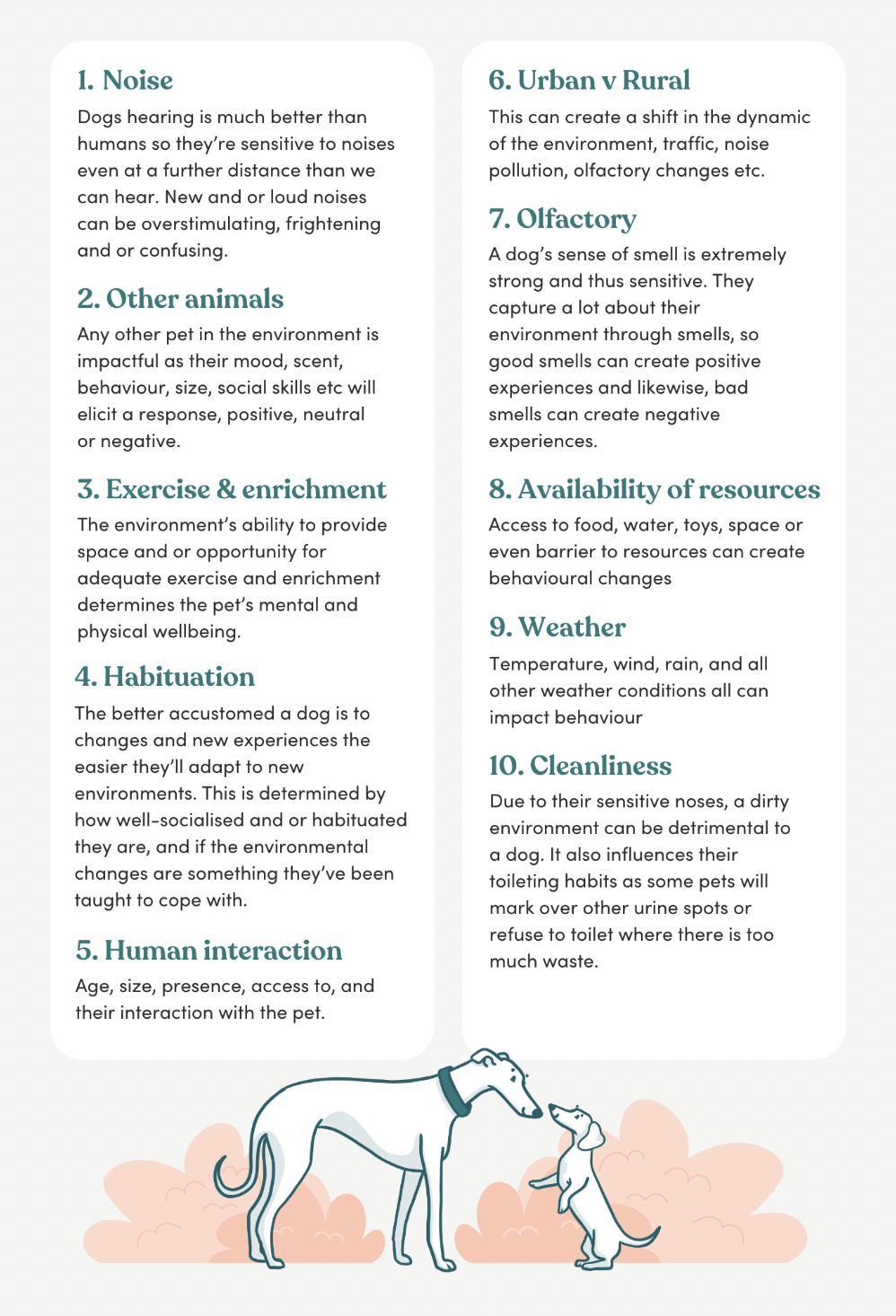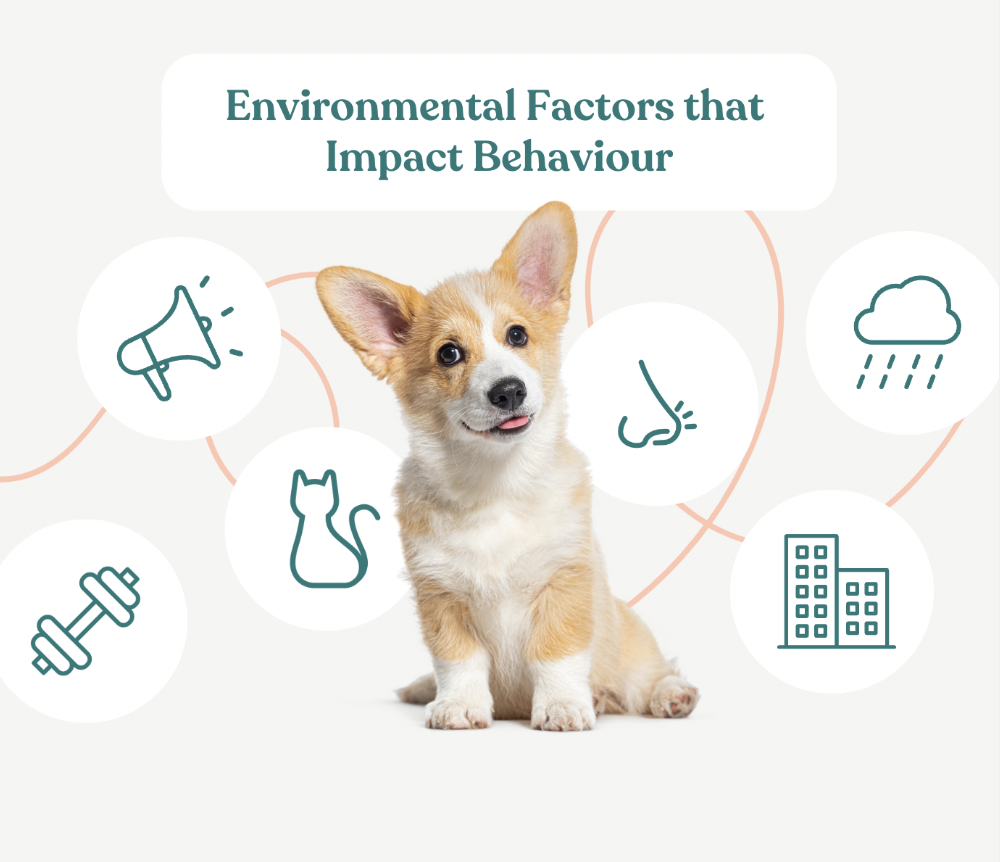Gone are the days of family pets spending their day alone in the backyard. The last decade has provided us with plenty of research and developments that taught us the best way to care for our furry friends.
As a pet parent, curating their ideal environment and meeting their physical and mental needs is more important than ever.
How environment impacts a pet’s behaviour
Dogs are highly influenced by their environment. Their sensitivity to environmental changes is dependent on their upbringing and previous experiences. Every component of an environment can impact a dog’s behaviour, and understanding how each component can impact a dog is crucial for their carer to create the ideal environment for them and or help them manage challenges in their environment. Dogs thrive off routine so the more consistent and calm their environment is, the better.
Why is consistency and calmness so important?
Dogs rely on routine – if they don’t have routine or consistency their behaviour can be as unpredictable as their environment. A consistent baseline is ideal. Feeding, walking, sleeping and the other basics happening at the same time each day can help a dog adapt to changes. If these essentials are inconsistent, however, it can be problematic.
When a dog doesn’t feel secure in their environment and feels like their needs aren’t being met, their behaviour will reflect this and they will seek to fulfil them themselves. This can manifest in unfavourable ways such as confusion, frustration, resource guarding or destructive behaviour. It can also manifest in the pet shutting down or refusing to do simple things like drinking water.
How important is socialisation?
How well a dog is socialised will influence their behaviour. Early exposure to diverse environments, people, animals, and stimuli helps dogs develop social skills, confidence, and resilience. Socialisation can be done at an older age if necessary, but is optimal in the critical learning stage of 0-20 weeks old. A lack of proper socialisation can lead to fear, anxiety, and aggression later in life. Socialisation and habituation go hand in hand. When done correctly, they will teach a dog how to confidently deal with the human world and have healthy boundaries for things like play and food.
 How changes in environment can impact a pet’s behaviour
How changes in environment can impact a pet’s behaviour
As each dog is an individual so is their response to their environment. This is where the responsibility falls on the carer to know the dog and cater to them. As a Pet Sitter, knowing their routine, regular environment and how well they cope with change is key to avoiding any behavioural issues.
With any change in environment – moving home temporarily, Owners leaving, living with other pets – a behaviour change should be expected.
The top 3 major changes for a Pet Owner, Pet Sitter or carer to consider are home changes, living with other pets and carer changeover. Proactive measures are the best way to minimise a negative reaction to the changes.
Tips for helping a pet adjust to a changing environment
Here are our top tips to understand how environment impacts a pet’s behaviour and how to help them adjust to change.
Change in a home:
- Bring their bed, food & water bowl, favourite toy or any other daily items that can bring them comfort and a sense of normality.
- Conduct a pre-visit so they can have a positive experience and create a sense of familiarity when they return.
- Go slowly – come in and spend some time settling the pet with you and ensuring they’re okay.
- Keep their same routine. Try to keep feeding, walking and bedtime at the same time so there is some consistency for them.
- Maintain boundaries and mimic what rules they know and understand. For example, not letting them on the couch if they’re not allowed usually.
Living with other pets:
- Do a slow introduction for each new pet entering the home.
- Ideally, allow the pets to meet in a neutral environment beforehand.
- Ensure each pet has a place they can go to rest or sleep where the others can’t disturb them. This is particularly important, as having a sanctuary that theirs will create a sense of safety and security.
- Keep the pets separated when feeding them.
- Monitor the pets to ensure they’re getting along.
- Ensure the space is adequate for the amount and size of pets living/staying there.
Carer changeover:
- If it’s a Pet Sitting booking, organise a Meet & Greet before the booking. If you’ve got time, do regular dog walks or occasional visits to build a bond before the booking starts.
- Be super positive – you want to create a ‘Santa Claus’ persona in the eyes of the dog! Making them feel that you are someone who is comforting, gives treats and cuddles, and looks forward to spending time with them.
- Maintain consistency – attempt to keep the same habits the Owner or previous carer has, such as sleeping in the bed or playing tug which strengthens your bond.
- Respect their boundaries. A dog might not be as comfortable with you as they are their Owner or a previous Carer so don’t rush into things like putting their harness on or picking them up. Listen to their body language and only engage in affection when they ask for it.
Consistency is key when managing a pets behaviour
Eating, drinking, sleeping and exercise habits are what you should prioritise keeping consistent. With any environmental change, if a dog is stressed, one of the first things that will change is their appetite. Like when a dog is nervous around someone new and won’t take treats. When a dog moves environments, they might not know where the water bowl is so it’s important to show them where it is and to keep an eye on how much they’re drinking. If a dog is too unsure to drink, you can always add water to their meals to ensure they’re not dehydrated.
When introducing change, make sure you recognise how environment impacts a pet’s behaviour and ensure you take an accommodating approach. Never just assume that the dog will act exactly as they do at home or as their Owner said, and cater the environment to suit and fill their needs.

